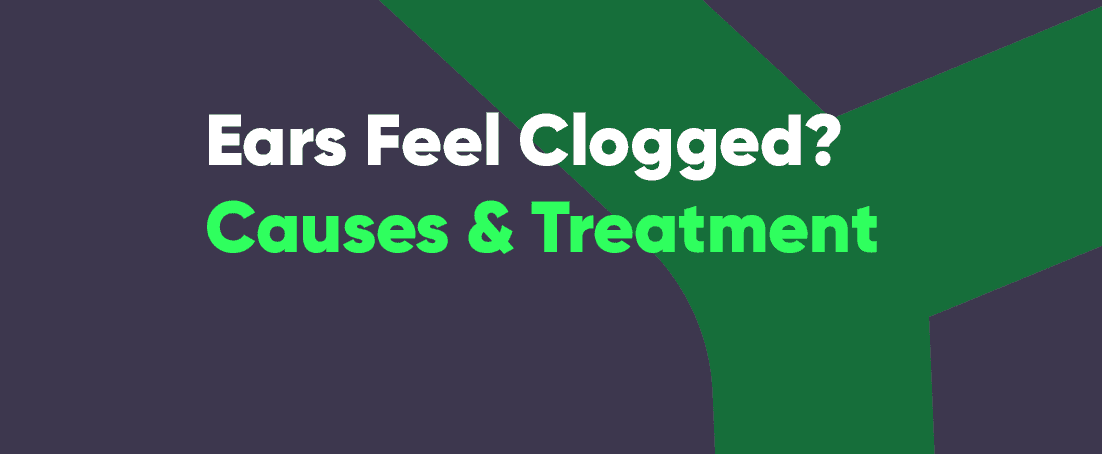Do you ever feel like your ears are underwater, muffled, or just plain plugged? It’s a frustrating sensation that can leave you feeling off-balance. Clogged ears are a common problem with various causes and rarely a cause of serious concern if it happens occasionally. If you feel clogging in the ears more often, many effective treatments are available.
In this article, we’ll list the most common reasons your ears might feel stuffed up and guide you through the best ways to find relief. So, let’s dive in and learn how to unclog your ears and clear your head for good!
Main Causes of Ear Clogging
Having clogged ears feels like your ears are filled with cotton wool. The culprits behind that annoying sensation could be hiding in plain sight. Understanding the causes is crucial for pinpointing the right solution so that you can regain clear and comfortable hearing. These are the main causes of ear clogging:
Blocked Eustachian Tube Dysfunction
Blocked Eustachian tube dysfunction is the most common cause of clogged ears sensation. The Eustachian tube that links your middle ear to the back of your throat is responsible for balancing the pressure inside the air. Ever experienced ear pain while swallowing or felt your hearing muffled? That’s the imbalance in pressure caused by this blockage. If the Eustachian tubes get narrowed, blocked, or inflamed for any reason, your ears feel full or plugged.
One of the triggering factors for blocked Eustachian tubes can be high altitudes when the ears feel the sudden change in atmospheric pressure. Other reasons could be colds, allergies, or hormonal changes during pregnancy.
Simple actions like yawning or chewing gum might offer temporary relief by opening this tube and balancing the pressure. Treatments for persistent or worsening symptoms range from decongestants and nasal sprays to, in severe cases, surgery. Until it’s resolved, following your healthcare provider’s advice and avoiding activities like flying or diving that can worsen ear clogging is crucial.
Ear Infections
Ear infections can lead to the sensation of ear clogging. Depending on the severity of a middle ear or outer ear infection, it will cause a variety of symptoms, including a blockage sensation. In some cases, particularly with outer ear infections, there might even be smelly ear wax as a sign.
Different types of ear infections trigger inflammation and fluid buildup, making your ears feel plugged up. If left untreated, the pressure and blockage worsen, impacting your hearing and causing distress. Seeking prompt medical attention is crucial to address the infection and relieve the clogged feeling.
Earwax Buildup
Earwax buildup can be one of the causes of ear clogging. When earwax accumulates excessively, it can block the ear canal, causing a feeling of fullness or clogging. Black earwax is one of the indications of stubborn earwax impaction.
Seeking proper guidance to safely clear the impacted earwax can restore that clear hearing and relieve the plugged-up sensation in your ears.
Cholesteatoma
Cholesteatoma, a growth behind the eardrum, might be causing blocked ears. The growth is benign and starts small but expands over time, causing a blockage. It obstructs the Eustachian tube, disrupting fluid drainage from the middle ear. This obstruction triggers discomfort, muffled hearing, and the feeling of fullness in your ear.
Chronic ear infections or poor Eustachian tube function can trigger Cholesteatoma. Treatment options vary, from antibiotics to manage infections to decongestants aiding fluid drainage. In severe cases, surgical removal might be necessary. Regular check-ins with an ear, nose, and throat specialist are crucial to monitor for any recurrence or complications.
Hearing Loss
Feeling like your ears are stuffed or full can sometimes be linked to hearing loss, also known as sensorineural hearing loss. This type of hearing loss stems from damage to the inner ear or the auditory nerve. While it often develops gradually with age, it can also affect younger individuals.
Sudden hearing loss might result from viral infections, exposure to loud noises, head injuries, autoimmune inner ear disease, or conditions like Meniere’s disease. If you experience sudden or new hearing loss, seeking guidance from your healthcare provider is crucial for proper evaluation and care
Covid-19
COVID-19 can lead to ear clogging by triggering inflammation and congestion in the nasal passages and throat, blocking the Eustachian tubes. Factors like inflamed mucous membranes, changes in air pressure, or even earwax buildup due to this inflammation can contribute to this clogged feeling.
To alleviate clogged ears from COVID-19, some simple methods might help, like swallowing, yawning, chewing gum, using nasal decongestants, or applying nasal steroids. If these don’t work, attempting the Valsalva maneuver helps (more on that below).
If these remedies don’t ease the symptoms, reaching out to a healthcare professional is vital. Persistent or worsening symptoms might need further evaluation and specific treatments.
Sinus Infections
Sinus infections can play a sneaky role in ear clogging. When your sinuses become inflamed and filled with mucus, the pressure builds, extending to the nearby Eustachian tube, which helps regulate air pressure. When the sinus inflammation blocks the tube’s function, the air pressure in your middle ear becomes imbalanced, leading to that uncomfortable feeling of fullness and pressure in your ear.
How to Unclog My Ears: Treatments for a Clogged Ear
At times, a clogged ear might just sort itself out, especially after changes in altitude or due to a simple cold. Your body’s natural mechanisms, like swallowing, yawning, or even just waiting it out, can often resolve this sensation.
However, if the clogged ear sensation sticks around, there are solutions mentioned below. If the DIY methods suggested here don’t do the trick, seeking guidance from a healthcare provider is the way to go. They can examine your ears, identify the cause, and recommend suitable treatments. For more severe cases, professional ear cleaning, earwax removal, or even prescribed medications might be necessary.
Dislodge Trapped Fluid
Several at-home methods can help you dislodge trapped fluid from your ears. Try gently jiggling your earlobe while tilting your head to encourage fluid movement. Or, use gravity to your advantage by positioning your head or lying on your side with the affected ear upward, allowing any trapped liquid to drain naturally.
You can also employ a hairdryer on its cool setting, maintaining a safe distance to create a gentle vacuum effect that aids in drying the ear canal. Over-the-counter ear drops or sprays might help dislodge the fluid temporarily, while applying a warm compress can alleviate discomfort and equalize pressure within the ear.
However, if these measures fail to alleviate the trapped fluid, medical intervention might be necessary to address these root causes and provide appropriate treatment for lasting relief.
Use the Valsalva Maneuver
To utilize the Valsalva Maneuver and ease ear discomfort, follow these steps:
- Prepare: Sit comfortably and gently close your mouth. Pinch your nostrils shut using your fingers.
- Inhale: Take a deep breath through your mouth.
- Exhale: With your nostrils still pinched, gently exhale while maintaining a steady pressure. You’ll feel a slight sensation in your ears, indicating the pressure change.
- Release: Slowly release your nostrils and resume normal breathing.
Be cautious not to exhale forcefully or excessively, as this could potentially cause damage to your ears.
Inhale Steam
Inhaling steam is a helpful remedy for unclogging ears, especially when caused by infections or allergies. The steam’s warmth thins mucus reduces inflammation, and eases congestion in the nasal passages and throat. This action also helps open up the Eustachian tubes, relieving pressure and discomfort in the ears.
To try this at home, boil water in a pot and remove it from the heat. Then, drape a towel over your head and the pot, creating a tent-like enclosure. Inhale the steam deeply by taking slow breaths. A hot shower also can produce similar steam effects that aid in relieving clogged ears.
Ear Drops
Using over-the-counter (OTC) ear drops is a helpful way to get rid of clogged ears, especially when the cause is an infection or allergies. They helps dislodge the trapped fluid or earwax impaction. Research suggests that softeners effectively remove earwax, which helps get rid of ear clogging.
Select the appropriate type of ear drops based on your symptoms and underlying cause. Warm the bottle by rubbing it with your hands before application to prevent dizziness. Position yourself correctly by lying with the affected ear up and gently pulling the ear back for better application.
Follow dosage instructions precisely to avoid overuse, and refrain from using drops if you suspect a ruptured eardrum. Monitor for side effects and seek medical advice if needed.
Hygiene Practices for Ear Health Care
Maintaining proper ear hygiene is crucial for optimal ear health. Earwax tells a lot about the condition and cleanliness of your ears, so you can read our guide to help identify earwax color and what it means. For instance, darker earwax might hint at accumulated debris, while a lighter shade suggests fresh, healthy wax. Flaky earwax often indicates effective cleaning, as it’s a sign of naturally shedding old wax.
Establishing regular cleaning routines ensures the removal of excess wax and debris, aiding in preventing blockages and potential issues. It is best to remove ear wax using a Tvidler, but it’s crucial to do so gently to avoid pushing the wax deeper. Proper hygiene practices, like gentle cleaning with a washcloth during showers, promote healthy ears by preventing wax buildup and maintaining cleanliness.
Sleeping Position
To ease discomfort from a clogged ear during sleep, consider these tips:
- Elevate your head: Use multiple pillows or adjust the headboard to aid fluid drainage and alleviate pressure in the middle ear.
- Sleep on the non-affected side: Resting on the opposite side of the blocked ear can enhance comfort and potentially aid drainage. This position may also assist in the absorption of prescribed ear drops.
- Switch positions regularly: Periodically changing sleep positions can help relieve pressure and discomfort.
- Tilt your head: Angle the affected ear upward for about 20 to 30 seconds to encourage fluid drainage.
Treatments Not Recommended for a Clogged Ear
It is strongly advised to seek personalized guidance from healthcare professionals before attempting any of the following remedies or treatments for ear-related concerns, including when they seem clogged. Professional advice ensures safety and effectiveness as it is tailored to individual needs, mitigating potential risks or complications.
Inserting Objects into the Ear
Using cotton swabs, fingers, or other objects can worsen ear blockages by pushing the wax deeper and potentially causing damage.
Candling
Inserting a lit, cone-shaped candle into the ear can lead to severe burns, perforations, or obstructions in the ear canal.
Chewing Gum for Children
While chewing gum can aid swallowing, it’s not recommended for children under six due to the risk of choking.
Hydrogen Peroxide
Using hydrogen peroxide ear drops for a clogged ear is not recommended, particularly if there’s a history of a ruptured eardrum, ongoing infection, or the presence of tympanostomy tubes. These drops can pose risks like ear canal infection, irritation, itchiness, pain, or contact dermatitis.
If your ears feel clogged, exploring alternative and safer earwax removal methods, such as gently massaging ear wax out or utilizing the most effective ear wax removal tools recommended by experts, is important. Seek personalized advice from a healthcare provider for the most suitable and safe options before attempting any remedies for ear blockages.
When to Seek Medical Attention Due to Stopped Up Ears
When suffering from a clogged ear, seeking medical attention is advisable if the condition persists beyond 48 hours despite attempting ineffective treatment methods. If symptoms endure beyond this time frame without relief or if they worsen despite attempts at self-care, consulting a doctor becomes essential. Constant or worsening clogged ears beyond this duration may indicate an underlying issue that requires professional evaluation and tailored treatment for effective relief.
Prevent Your Ears from Feeling Stuffy with This Strategy
To prevent your ears from feeling stuffy, consider these lifestyle adjustments:
- Maintain proper ear hygiene: Clean your ears gently and regularly to prevent wax buildup and potential blockages.
- Avoid inserting objects: Refrain from using cotton swabs or other objects that can push wax deeper into the ear canal, causing blockages.
- Protect your ears: Use earplugs or earmuffs in noisy environments to shield your ears from excessive noise exposure, reducing the risk of damage or discomfort.
- Stay hydrated: Drinking adequate water can help maintain ear health by preventing excessive dryness in the ear canal.
- Address allergies: Manage allergies promptly to prevent inflammation or congestion that could affect your ears.
- Practice safe swimming: Wear earplugs while swimming to prevent water from entering the ear canal and causing infections.
- Seek professional guidance: If ears feel clogged, consult with a healthcare provider for personalized advice on maintaining optimal ear health.
Managing ear clogging involves several precautionary measures and safe practices. Protection in noisy environments, hydration maintenance, prompt allergy management, and seeking professional guidance are crucial for optimal ear health. These practices collectively safeguard against discomfort, infections, or potential complications, emphasizing the significance of proactive care and personalized advice for maintaining healthy ears.
Summarizing The Issue of Clogged Ears
Clogged ears can stem from issues like excessive earwax, infections, or changes in air pressure. Treatments include gentle cleaning, steam inhalation, or consulting professionals for safe and effective remedies customized to individual needs.





